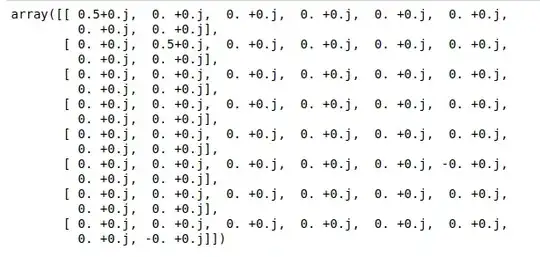I am trying to write Toffoli gate matrice by using one and two qubit gates matrices. I follow this circuit
I first started to write the matrices of one and two qubit gates:
identity = np.array([[1, 0], [0, 1]])
xgate = np.array([[0, 1], [1, 0]])
ygate = np.array([[0,-1j],[1j,0]])
zgate = np.array([[1,0],[0,-1+0j]])
hgate = 1/math.sqrt(2)*(xgate+zgate)
sgate = np.sqrt(zgate)
tgate = np.sqrt(sgate)
tdag = tgate.conj().T
cnot = 0.5*(np.kron(identity,identity)+np.kron(identity,xgate)+np.kron(zgate,identity)-np.kron(zgate,xgate))
deneme = np.kron(identity, swap)
deneme2 = np.kron(cnot,identity)
deneme3 = np.kron(identity,swap)
#deneme_ = deneme*deneme2*deneme3
deneme_ = np.matmul(deneme,deneme2)
non_adjacent = np.matmul(deneme_,deneme3)
Then, I started to write each part of the circuit in the following way:
tof1 = np.kron(np.kron(identity,identity),hgate)
tof2 = np.kron(identity,cnot)
tof3 = np.kron(np.kron(identity,identity),tdag)
tof4 = non_adjacent
tof5 = np.kron(np.kron(identity,identity),tgate)
tof6 = np.kron(identity,cnot)
tof7 = np.kron(np.kron(identity,identity),tdag)
tof8 = non_adjacent
tof9 = np.kron(np.kron(identity,tdag),tgate)
tof10 = np.kron(cnot,hgate)
tof11 = np.kron(np.kron(identity,tdag),identity)
tof12 = np.kron(cnot,identity)
toffoli = tof1*tof2*tof3*tof4*tof5*tof6*tof7*tof8*tof9*tof10*tof11*tof12
My guess is that: I did a mistake when I tried to write cnot gate for the first and third qubits or maybe I am wrong to write identities
Can someone explain to me what I missed? Sorry for this dumb question Thanks in advance


tof4 = np.matmul(swap,cnot) tof4 = np.kron(tof4,identity)#and I did the same for tof8 too but the result is still weird – quest Dec 28 '21 at 11:43*instead of@to combine the pieces. For numpy,*is pair-wise product, and@is matrix multiplication. – Craig Gidney Dec 29 '21 at 00:08